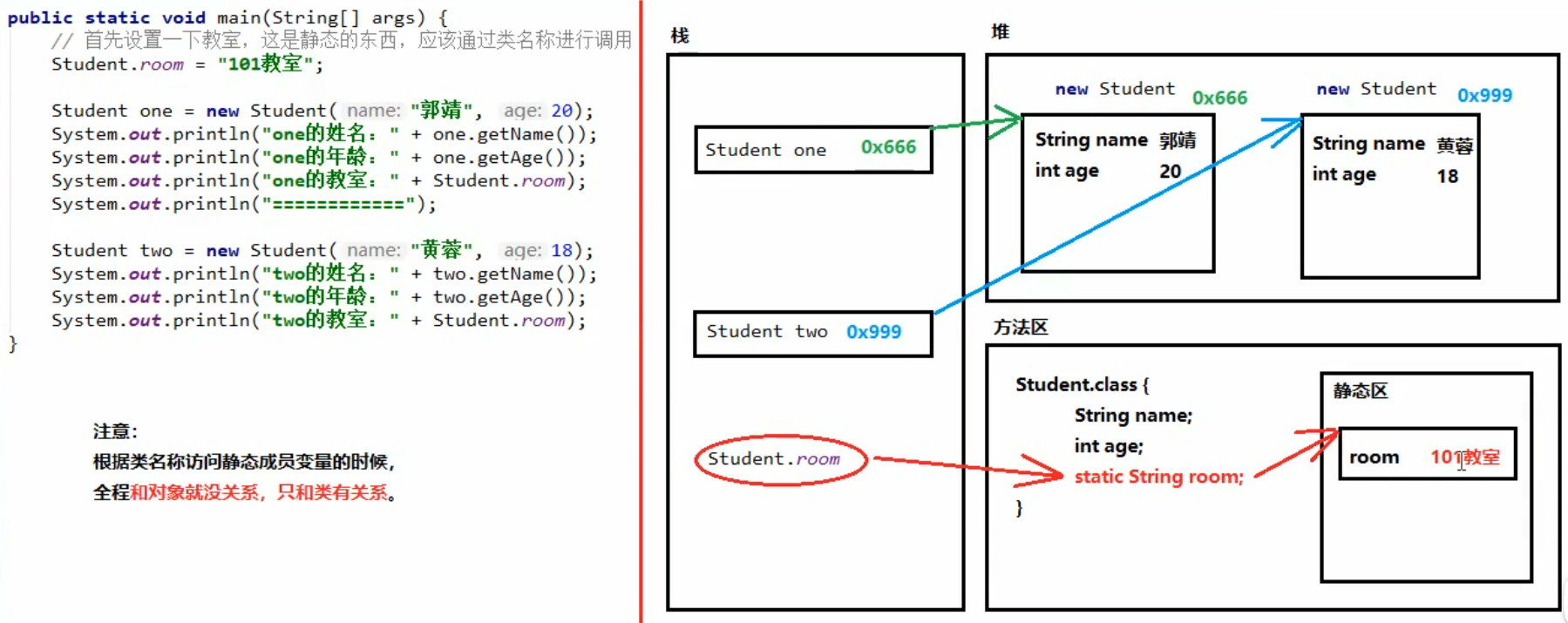static
静态static关键字修饰成员
在一个类中,如果使用static关键字来修饰类属性(成员变量),那这个变量就属于类,类里面的所有对象都可以共享这个变量。
什么意思呢?我们看一下代码就明白了:
现在有一个类Student
package static_demo;
public class Student {
private String name;
private int age;
static String room;
public Student() {
System.out.println("调用空Student");
}
public Student(String name, int age) {
System.out.println("调用带参Student");
this.name = name;
this.age = age;
}
public String getName() {
System.out.println("调用getName方法");
return name;
}
public void setName(String name) {
this.name = name;
}
public int getAge() {
System.out.println("调用getAge方法");
return age;
}
public void setAge(int age) {
this.age = age;
}
public static String getRoom() {
System.out.println("调用getRoom方法");
return room;
}
public static void setRoom(String room) {
Student.room = room;
}
}
然后我们下面这个函数调用Student类实例化两个Student成员对象one和two、并且定义one.room= "101教室",这里two可以不声明而直接使用!这就是因为在Student类中我们通过static来修饰room这个变量,room不是one对象的,虽然他对其做了声明,但是room是属于Student类的,不管创建几个Student的成员对象,成员之间都是共享一个room,这个room属于Student类。
package static_demo;
public class staticField {
public static void main(String[] args) {
Student one = new Student("郭靖",19);
one.room = "101教室";
System.out.println("姓名:" + one.getName() + ",年龄:" + one.getAge() + "所在教室:" + one.room);
Student two = new Student("黄蓉",16);
System.out.println("姓名:" + two.getName() + ",年龄:" + two.getAge() + "所在教室:" + one.room);
}
}
在这个例子里,没有执行到空Student对象public Student()
下面我们实现这样一个效果:每次new Student对象都做一个加一操作,让学号递增。
也很简单,Student类代码如下
package static_demo;
public class Student {
private int no; //学号
private String name;
private int age;
static String room;
private static int noCounter = 0; //学号计数器
public Student() {
System.out.println("调用空Student");
noCounter++;
}
public Student(String name, int age) {
System.out.println("调用带参Student");
this.name = name;
this.age = age;
this.no = ++noCounter;
}
public int getNo() {
return no;
}
public void setNo(int no) {
this.no = no;
}
public static int getNoCounter() {
return noCounter;
}
public static void setNoCounter(int noCounter) {
Student.noCounter = noCounter;
}
public String getName() {
System.out.println("调用getName方法");
return name;
}
public void setName(String name) {
this.name = name;
}
public int getAge() {
System.out.println("调用getAge方法");
return age;
}
public void setAge(int age) {
this.age = age;
}
public static String getRoom() {
System.out.println("调用getRoom方法");
return room;
}
public static void setRoom(String room) {
Student.room = room;
}
}
调用类的代码
package static_demo;
public class staticField {
public static void main(String[] args) {
Student one = new Student("郭靖",19);
one.room = "101教室";
System.out.println("姓名:" + one.getName()
+ ",年龄:" + one.getAge() + "所在教室:" + one.room + ",学号:" + one.getNo());
Student two = new Student("黄蓉",16);
System.out.println("姓名:" + two.getName()
+ ",年龄:" + two.getAge() + "所在教室:" + two.room + ",学号:" + two.getNo());
Student oyf = new Student("欧阳锋",56);
System.out.println("欧阳锋的学号是:" + oyf.getNo());
Student yg = new Student("杨过",14);
System.out.println("杨过的学号是:" + yg.getNo());
Student xln = new Student("小龙女",16);
System.out.println("小龙女的学号是:" + xln.getNo());
}
}
输出
调用带参Student
调用getName方法
调用getAge方法
姓名:郭靖,年龄:19所在教室:101教室,学号:1
调用带参Student
调用getName方法
调用getAge方法
姓名:黄蓉,年龄:16所在教室:101教室,学号:2
调用带参Student
欧阳锋的学号是:3
调用带参Student
杨过的学号是:4
调用带参Student
小龙女的学号是:5
静态static内存图

静态代码块
静态代码块的格式:
public class 类名称{
static {
//静态代码块的内容
}
}
特点:
-
当第一次用到本类时,静态代码块执行唯一的一次。
-
静态内容总是优先于非静态,所以静态代码比构造方法先执行。
静态代码的典型用途:
用来一次性地对静态成员变量进行赋值。
Person类
package static_demo;
public class Person {
static {
System.out.println("静态代码块执行!");
}
public Person(){
System.out.println("构造方法执行!");
}
}
调用类
package static_demo;
public class P_staticDemo {
public static void main(String[] args) {
Person a = new Person();
Person b = new Person();
}
}
输出
静态代码块执行!
构造方法执行!
构造方法执行!